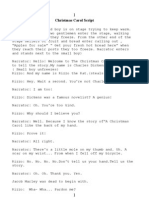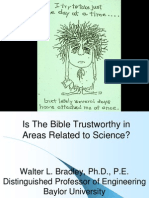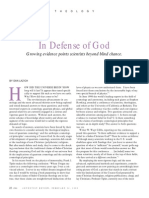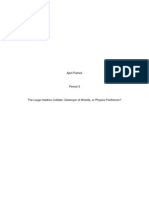Professional Documents
Culture Documents
23actual Paper Apolos
23actual Paper Apolos
Uploaded by
Manny SelvarajOriginal Description:
Original Title
Copyright
Available Formats
Share this document
Did you find this document useful?
Is this content inappropriate?
Report this DocumentCopyright:
Available Formats
23actual Paper Apolos
23actual Paper Apolos
Uploaded by
Manny SelvarajCopyright:
Available Formats
Asses the apologetic value of contemporary teleological arguments for the existence of God
Introduction This paper will explore the apologetic value of contemporary1 teleological arguments for the existence of God: In particular the design inference from the fine-tuning of the universe and biological complexity by the Intelligent Design movement.
Contemporary Teleological Arguments Teleological arguments or design arguments, as commonly referred, has been both historically and recently a popular argument for the existence of God.2 They are based primarily on the notion that the universe has order, purpose and regularity. This complexity of the universe illustrates design thus implying a need for an adequate designer speculated to be God.3 Historically, the discourse was simply analogical and based on the
aforementioned belief with no empirical evidence. Such arguments include that of, the Nyya system of Hinduism (100-1000 CE) in Ancient India, Heraclitus, Plato, Aristotle, the Stoics and St. Thomas Aquinas.4 Contemporary arguments, however alike in concept, use modern science as their benefactor as well as employing a probabilistic logic. However, agreeing on the precise logical structure in presenting the argument is disagreed.5 Despite
The author will allow this to extend till the 1960s, the emergence of the finely-tuned possibility of life. S. Meyer, Evidence of Design in Physics and Biology, in M. Behe, W. Dembski, S. Meyer, eds., Science and Evidence for Design in the Universe, (San Francisco: Ignatius Press, 2000), 56. 2 R. Collins from the Blackwell companion, 202. 3 Use either an apologetic dictionary or Philosophy book. 4 Mrs. Manning, Ancient and Mediaeval India, Vol. I, (London: H. Allen and Co., 1869), 186. Krishna Banerjea, Dialogues on the Hindu Philosophy, Comprising The Nyaya, The Sankhya, The Vedant, (Calcutta: Thacka Soink and Co.), 64. P. Moser, P. Copan, The Rationality of Theism, (London: Routledge, 2003), 132. 5 Manson, 5.
the divergence the majority assert that it is most effectively presented involving probabilities at some level, especially in regards to fine-tuning arguments.6
The fine-tuning argument The fine-tuning argument is considered to be the cutting-edge of the contemporary discussion.7 The initial stages, however, can be noted in Natural Theology8as Paley
addressed a similar argument only to have it overlooked because of, what Collins attributes it to be, limited detail in physics and astrophysical knowledge at that time. Nevertheless, in light of modern scientific development it has evolved to become a leading contemporary argument based on design.9 The examples of fine-tuning fall under two categories:10 the fundamental constants of physics that go into the laws, and the initial state of the universe. The writer, however, will consider in brief only two instances from each sort as the paper aims primarily to emphasise the arguments apologetic value or the lack thereof than to elucidate them to a culmination.
The Strong Nuclear Force The apparent fine tuning of the strong nuclear force is vital for the existence of life as it plays a critical role in synthesis of Carbon. Sharpe and Walgate write: Of all the elements that
6 7
Manson....8. But also give name examples. W. Craig, God is Not Dead Yet, 24. 8 W. Paley, Natural Theology, (London: Taylor and Wilks, 1802), 409-474. 9 Moser & Copan, 133. 10 Holder, 5. Craig, 24. Whilst Holder and Craig, join the fundamental constants with the laws of nature, Collins doesnt thus grouping them into three including the initial conditions. Collins in Companion to natural theology, 202. This paper evidently favours Holder and Craig as the two are interlinked.
exist none comes close to the potential for complex chemistry possessed by Carbon. 11 This attested by many others.12 Carbon, along with other elements, is manufactured inside stars by the processes of nuclearsynthesis.13 The protons must first join each other to form more complex particles releasing high energy in the process.14 This, however, is problematic due to the mutual electromagnetic repulsion between protons. Therefore, this repulsion must be eliminated by converting
proton into neutrons. The colloquial saying easier said than done comes to mind as this conversion is an elaborate process occurring over billions of years.15 The strong nuclear force is responsible for binding nuclei together.16 Suppose, however, the strong force were to be one percent stronger; this would be sufficient to overcome the repulsion of the protons directly.17 Nonetheless, it would result in the burning of all the carbon into oxygen as the nuclear resonance levels would be altered.18 There is also the potential of the stars exploding, compressing a billion years of nuclear reactions into a single second.19 Assume a two percent increment of the strong force; protons composition from quarks would be inhibited as a result protons would cease to exist along with atoms, elements and compounds that compose much of cosmos. Additionally, decreasing the strong force by five percent would unbind deuteron, the nucleus of deuterium an isotope of hydrogen required for nuclear synthesis, resulting in a universe composed only of hydrogen.20
11
K. Sharpe, J. Walgate, The Anthropic Principle: Life in The Universe, Zygon, Vol. 37 No. 4, (Dec 2002), 925940. Pg, 929 12 Holder, 6. Manson, 184. Debating Design, 246. 13 Holder, 6. Manson, 184. Debating Design, 246. 14 K. Sharpe, J. Walgate, 928. 15 K. Sharpe, J. Walgate, 928. 16 Holder, 6. 17 K. Sharpe, J. Walgate, 928. 18 Craig in Manson, 156. Holder, 6. 19 K. Sharpe, J. Walgate, 928. 20 Craig in Manson, 156.
Gravity Gravity similar to the above example must be within certain values in to for the universe to allow for the emergence of life. Collins cites work of Brandon Carter which show that if gravity had been weaker or stronger by one part in 1040, then stars could not exist.21 The implications if this are great. No star, no nuclear synthesis therefore no elements including carbon and oxygen crucial for the existence and sustenance of life.22 Moreover, if the strength of gravity were to be increased by a billion-fold, the force would crush any land-based organisms anywhere near the size of human beings.23
The ratio of matter to antimatter At its initial phase, the universe is endowed with surplus baryons, affected by the strong nuclear force, over its conjugate anti-matter (109 + 1 particle in 109).24 The asymmetry, though miniscule, is accounted for through theories of strong, weak and electromagnetic interactions. Prior to proceeding, one must understand, when in close propinquity, matter and antimatter annihilate each other producing high energy photons.25 Suppose the proportions of matter and antimatter were symmetrical, galaxies would not have formed due to the deficit in matter as a consequence of annihilation, therefore, inhibiting the process of cosmic progression galaxies, stars, planets and life.26
21
R. Collins, A Scientific Argument for the Existence of God, in M. Murray, Reason For the Hope Within, (Grand Rapids: Eerdmans, 1999), 49. 22 Holder, 6 23 Collins in Manson, 189. 24 Holder, 7. 25 J. Lach, Antimatter, in McGraw-Hill Encyclopedia of Science and Technology, Vol. 1, (New York: McGrawHill Book Company, 1987) 644. 26 M. Corey, God and The New Cosmology, (Maryland: Rowman and Littlefield, 1993),44
Initial rate of expansion The initial rate of expansion of the universe is an exceptional fine tuning argument. Hawking writes "If, the rate of expansion one second after the big bang had been smaller by even one part in a hundred thousand million million, the universe would have recollapsed before it ever reached its present state."27 On the other hand, an untimely increase in the rate of expansion by one part in a million would have expanded too quickly for the formation of galaxies and stars to take place. To avoid both the above scenarios the initial rate had to have been finetuned.28
As illustrated above modern progression in the sciences depict with detail the fragility of the universe from constraints of physics which if altered would be severely life inhibiting. 29 Craig remarks: were these constants and quantities to be altered by less than a hair's breadth, the life-permitting balance would be destroyed, and life would not exist.30 Consequently, it is appropriate to culminate recognizing Craigs use of hyperbole31 that the fine-tuned cosmos is essential for the existence of intelligent life forms.32 Explanations for the above discussed fine-tuning are varied; design being just one of them. Design, currently, is inferred by eliminating other alternatives chance and necessity to suggest design is the most probable of the options.33 This may be executed either in formulated steps Dembski34 does or by mathematically highlighting the improbabilities
27
S. Hawking, A Brief History of Time: From the Big Bang to Black Holes, (New York: Bantam Press, 1988), 12122. 28 C. Mooney, The Anthropic Principle in Cosmology and Theology, 110-111. From wales 29 N.Geisler,I Dont Have Enough Faith to be an Atheist,(Illinois:Crossway,2004),96. Collins, in Manson, 180. 30 W. Craig, God Is Not Dead Yet, 24-25. 31 The writer, here, is referring to the use of hairs breadth. 32 P. Clayton, God, and Contemporary Science, (Edinburgh: Edinburgh University, 1997), 132. 33 Find People......Manson perhaps? 34 Use Mere Creation or Design and God.
for such fine-tuned universe by chance. For instance Penrose calculates the improbability of all the conditions required aligning itself for the universe to produce planets by chance to be 10-124 therefore impossible.35 Hoyle proposes an improbability of 10-40000 for occurrence of vital enzyme by chance.36 The overwhelming improbabilities for the emergence of life permitting universe can be an immense apologetic tool used as empirical evidence for design.
Apologetic Value of Fine-Tuning Arguments The arguments seem to hold immense apologetic value due to the detailed data presented for the assertions. Particularly as the figures are scientifically legitimate37 and accepted by atheists.38 For instance Stenger, an atheist, states I do not dispute that life as we know it would not exist if any one of several of the constants of physics were just slightly different.39 However, the theists interpretation of the evidence remains contested. Further on, Stenger states anyone who insists that our form of life is the only one conceivable is making a claim based on no evidence and no theory.40 Yet contradicting himself, he highlights an argument An Infinity of Universe against design that is based on no evidence and no theory.41 The theory states that the fine-tuned universe is highly improbable by chance if one assumes this was only one. But, if there were infinity of universe the existence of one as fined tuned as the one we perceive is highly probable; thus, eliminating a need for design. The desperation in proving design wrong has caused the advocators to go
35
R. Penrose, The Emperor's New Mind, 343-344, in http://plato.stanford.edu/entries/teleologicalarguments/index.html accessed on 31st October 2010. 36 Hoyle, Frederick, 1982. The Universe: Past and Present Reflections, 4-5 in http://plato.stanford.edu/entries/teleological-arguments/index.html accessed on 31st October 2010. 37 This is a claim based on scientific advancements thus far. 38 This is attested by W. Craig from his experience debating with numerous atheists: he states his respondents never dispute the scientific facts. W. Craig in S. Wallace, Does God Exist?, (Burlington: Ashgate, 2003), 163. 39 V. Stenger, in Why Intelligent Design Fails, 180. 40 V. Stenger, in Why Intelligent Design Fails, 180. 41 V. Stenger, 182-182.
against their rules. Holder dismisses the speculation as it is a metaphysical explanation for life not scientific. Moreover, as Dembski states it [has] proven too thin an explanatory soup on which to nourish a robust science.42 Dawkins, alike Stenger, rejects religious interpretation as it apparently has no evidence and views unwarranted. 43 And according to their criteria set for religion this theory must also be discarded. Another strength to the apologetic case of the argument is that it is not subject to Humes criticism faced by Paley for identifying, from the data directly, the designer as the Christian Creator God. Such an understanding is the result of extrapolating the evidence into the Christian world-view. This supposition is contested by many theists44 not to mention atheists.45 The writer empathises with such refute since the argument fails scientifically to indicate the existence of a divine being but rather invokes a designing intelligence. 46 At face value this seems to depreciate the apologetic potency contrary to the narrators opening sentence of the paragraph. Nevertheless, as Dembski expounds, in actuality it achieves the preferred by discarding any notion that science is capable of accounting for all patterns of nature without a higher entity.47 Clayton, in harmony, stresses the criticality of the task above and states only if theologians are successful at this task will the door be opened for a theological interpretation of natural science.48 After this point the apologete may be develop and expand, using other arguments philosophical or theological, to attribute the identity of the designer to the Trinitarian Christian God.
42 43
W. Dembski, J. Richards, Unapologetic Apologetics, (Carlisle: Paternoster Press, 2002), 242. R. Dawkins, in Gods undertaker, 15. 44 F. Beckwith, W. Craig, J. Moreland, To Everyone An Answer, (Illinois: Inter-Varsity Press, 2004), 79. Name the people... 45 Example of To everyone an answer, 58. Find atheists also. Hume. V. Stenger. 46 One must understand that such argument may be extended philosophically and theologically but not scientifically. M. Behe, in Manson, 277. 47 F. Beckwith, W. Craig, J. Moreland, To Everyone An Answer, (Illinois: Inter-Varsity Press, 2004), 79. 48 Clayton, 133.
Biological Complexity It is intriguing to note the various shifts in the classical arguments to the contemporary. For instance, while the traditional based design primarily on beauty and the aesthetically appealing, the current focuses on complexity of organisms.49 An earlier version of the biological complexity argument can be traced back to Paley regarding the intricacy, order and purpose of the mammalian eye.50 Though faced with much scrutiny from the likes of Hume, it wasnt until Darwins theory of evolution through natural selection that Paleys argument was no longer viable.51 Darwins theory offered a naturalistic explanation for the origin of biochemical organisms thus making the designer redundant. Behe, therefore, a proponent of biological complexity, starts with the challenge posed by Darwin: If it could be demonstrated that any complex organ existed which could not possibly have been formed by numerous, successive, slight modifications, my theory would absolutely break down.52 Behe claims to have met his challenge as advancements in biology over the past half century show numerous cell structures for specific tasks that are irreducibly complex.53 Such a system is defined as a single system which is composed of several well-matched, interacting parts that contribute to the basic function, and where the removal of any one of the parts causes the system to effectively cease functioning. 54 These
49 50
Find someone! God, theistic proofs.... 51 Collins, in rationality for theism or Blackwell.. 52 Darwin 1999 [1859]: 154, in Manson, 279. 53 Behe, in Manson, 280. 54 Behe, Darwins Black Box, 39. (Dembski 1999, 147)
irreducibly complex systems, supposedly, would absolutely break down Darwins theory.55 The examples offered are many but the paper will briefly consider four. Bacteria Flagellum The bacterial flagellum is a rotary propeller that enables bacteria to move or swim as Behe states it. It consists of several components that allow it to have its function. The flagellin filament - the propeller, the hook protein that joins the propeller to the drive shaft, the motor, a stator that keeps the structure stationary and bushing material.56 The resemblance of the flagellum to human built machines is intriguing. If even one part were not to function or removed the whole system would break down.57
A Cilium
A cilium is a centriole based, motile cell structure responsible for mobility when free like the sperm or if the cell is stationary like the cells lining the respiratory tract the cilia moves liquid over the surface of the cell.58 The cilia, however, are irreducibly complex as explicated by Behe. A cilium cannot perform its function unless its microtubules, nexin linkers, and motor proteins are all arranged and structured in precisely the manner in which they are structured; remove any component from the system and it cannot perform its function.59
55 56
M. Behe, Darwins Black Box, 39. Behe, in Manson, 280. 57 Behe, Black Box, 72. 58 Behe, Black Box, 59. 59 Behe, Black Box, 59-65.
Blood Clotting
Blood plays an important role in the body, clotting being one of them. The complex composition of blood is changes constantly during stress, starvation, exercise, as a result of ill-health and when injured.60 Similarly, the blood-clotting function cannot perform its function if either of its core elements, thrombin, fibrinogen, vitamin K and antihemophilic factor, were missing. This too is an intricately irreducible complex.61
Based on these examples one may infer design, as Behe does, to be a better explanation than the one offered by Darwin and his faithful followers.
Apologetic Value The arguments apologetic value is undeniable. However, not only is the inference to design contested but also the biochemistry used. For instance, Miller is convinced, based on apparent evidence, that Behe is wrong and the evolution of complex multipart biochemical systems is possible as observed in the laboratory.62 Nevertheless, when examined, this supposed evidence referred by Miller does not substantiate his extravagant claims rather the mutations were merely enhancements of pre-existing activities of the proteins, not an case for evolution.63 Therefore Behe confidently concludes that the results do not support the claims for the creativeness of the Darwinian processes.64
60 61
N. Russell, Blood Biochemistry, (Beckenham: Croom Helm, 1982), 3. Behe, Black Box, 79-81. 62 Miller, in Manson, 283. 63 Behe, in Manson, 284. 64 Behe, in Manson, 285.
Miller argues further his case convincingly using various other studies.65 Nevertheless, Behe disputes Miller and others alike using science purporting his view.66 Millers claims though at face value seem convincing; Behe deems them inaccurate interpretations of the evidence out. The writer speculates this to be desperation on Millers part in proving Behes stance wrong. It is, however, in the papers opinion, not surprising considering what is at stake for the biological community and the Darwinians. The minimalist argument of Behe, alike fine-tuning, is also effective apologetically. As he does not make the same mistake as Paley and take it so far as to attribute an identity to the designer. It is, therefore, argued that some biological systems at the molecular level appear to be the result of deliberate intelligent design. Swift too considers design as the most reasonable inference, from applying the scientific method to nature, not as an alternative to the scientific method.67 He also states that the combined specificity and complexity of biology at the molecular level completely defies any realistic possibility of life arising naturally.68 In order to avoid Dawkins accusation of arguing from personal credulity69 as a result his work discredited. Swift stresses that his conclusions are based on what is known of molecular biology and inability of natural processes to generate anything like the specificity and complexity that are required. 70 The arguments for intelligent design seem, to the writer, to be just as compelling and convincing as the arguments against it.
65 66
Miller, in Manson, 300. Behe, in Manson, 30067 D. Swift, A Scientific Critique of The Theory of Evolution in Debating Darwin, (Carlisle: Paternoster, 2009), 124. 68 Swift, 125. 69 Dawkins, Watchmaker, Chapter 2. 70 Swift, 125.
He states the fact that modern intelligent design theory is a minimalist argument for design, not an argument for the existence of God, relieves it of much of the baggage that seemingly weighed down Paleys argument. philosophical ore theological.71 Behe proposes that, rather than Darwinian evolution, a more compelling explanation for these irreducibly complex molecular machines discovered in the cell is that they were indeed designed by an intelligent agent.72 The value may be further seen as Milner and Maestro state that Intelligent Design has gained the attention of some political and educational circles and are currently the subject of a debate within the Ohio Board of Education.73 He emphasises that his argument is scientific, not
Conclusion It is apparent from this paper the apologetic value of the arguments. It has also been noted that scientific development offers the arguments much of their value. Though they fail to prove the existence of God they highlight the need for an intelligent designer. Whilst this limits the contemporary arguments yet it achieves to eliminate the concept of sciences ability to account for everything. The extension of the argument may be proceeded philosophically and theologically to suggest first, the existence a divine being and then to propose the Christian God.
71 72
Manson, 277. Behe, in Manson, 281. 73 R. Milner and V. Maestro, Introduction, in Intelligent Design?, Accessed at http://www.actionbioscience.org/evolution/nhmag.html on 31st October 2010.
Moreover, in the papers opinion the arguments based on the non-organic sciences to hold more value as it is not subject to the Darwinian theories. Furthermore the science is atleast accepted, whereas the biology the science is heatedly disputed.
You might also like
- Muppet Christmas Carol Script WordDocument41 pagesMuppet Christmas Carol Script Worddymphna5784% (19)
- Fight CPS HandbookDocument60 pagesFight CPS Handbookfree100% (4)
- Melville - The Russian Face of Germany - An Account of The Secret Military Relations Between The German and Soviet-Russian Governments (Abmachungen) (1932)Document222 pagesMelville - The Russian Face of Germany - An Account of The Secret Military Relations Between The German and Soviet-Russian Governments (Abmachungen) (1932)IAmSimone100% (3)
- Australian Model Railway Magazine-October 2021Document74 pagesAustralian Model Railway Magazine-October 2021Tim de Ruiter100% (1)
- Natural Explanations For The Anthropic Coincidences - Victor Stenger 17Document17 pagesNatural Explanations For The Anthropic Coincidences - Victor Stenger 17surveyorkNo ratings yet
- Looking For The God Particle at The Large Hadron Collider: Mary Beth de RepentignyDocument7 pagesLooking For The God Particle at The Large Hadron Collider: Mary Beth de RepentignymonishawindNo ratings yet
- Victor Strenger Fallacies Por Robin CollinsDocument24 pagesVictor Strenger Fallacies Por Robin CollinsIlan JimenezNo ratings yet
- The Question On Origin of The Universe and Big Bang: Krishna Raj AdhikariDocument4 pagesThe Question On Origin of The Universe and Big Bang: Krishna Raj AdhikariBilal SalaamNo ratings yet
- Is The Bible Trustworthy in Areas Related To Science? by Walter BradleyDocument71 pagesIs The Bible Trustworthy in Areas Related To Science? by Walter Bradleyrobb_wilson_2No ratings yet
- Fine Tuned UniverseDocument36 pagesFine Tuned Universeiryll78e2100% (3)
- The Evolving Universe: The Evolving Universe, Relativity, Redshift and Life from SpaceFrom EverandThe Evolving Universe: The Evolving Universe, Relativity, Redshift and Life from SpaceNo ratings yet
- Anthropic Cosmological Principles - Coments TheologyDocument7 pagesAnthropic Cosmological Principles - Coments TheologyCarlos Alberto Monteiro da SilvaNo ratings yet
- Anthro PhiloDocument23 pagesAnthro PhiloSidharth TomNo ratings yet
- Anthropic Principle: Jump To Navigationjump To SearchDocument5 pagesAnthropic Principle: Jump To Navigationjump To SearchUnknown UserNo ratings yet
- Aps 2002 PosterDocument1 pageAps 2002 Postergabi_xyzNo ratings yet
- Origin of The Universe: Patrick Vindel D. Cruz Beed IiDocument9 pagesOrigin of The Universe: Patrick Vindel D. Cruz Beed IiPatrick CruzNo ratings yet
- Ekpyrotic UniverseDocument3 pagesEkpyrotic UniverseRahul SahaNo ratings yet
- Conflict CoherenceDocument69 pagesConflict CoherenceSathya PooraniNo ratings yet
- Transcendental Minds and Mythical Strings: The Emergence of Platonism in Modern PhysicsDocument73 pagesTranscendental Minds and Mythical Strings: The Emergence of Platonism in Modern PhysicsAdair Mendoza PérezNo ratings yet
- John Losee - Complementarity, Causality, and Explanation-Transaction Publishers (2013) PDFDocument155 pagesJohn Losee - Complementarity, Causality, and Explanation-Transaction Publishers (2013) PDFbarry_8100% (1)
- Origin of The Universe SlideDocument36 pagesOrigin of The Universe SlidechielseaobquiaNo ratings yet
- Big History GlossaryDocument28 pagesBig History GlossaryThu Ngan NguyenNo ratings yet
- In Defense of GodDocument4 pagesIn Defense of GodVICTORDYKES6209No ratings yet
- Physical Science ModuleDocument35 pagesPhysical Science ModuleGajulin, April JoyNo ratings yet
- Big BangDocument22 pagesBig BangZoltán GesterNo ratings yet
- Constructive Interference: Developing the brain's telepathic potentialFrom EverandConstructive Interference: Developing the brain's telepathic potentialNo ratings yet
- Barnes FineTuningNaturesLaws 2015Document12 pagesBarnes FineTuningNaturesLaws 2015Sofia NunniniNo ratings yet
- Formation of ElementsDocument4 pagesFormation of ElementsRobertNo ratings yet
- DR UnificationDocument4 pagesDR UnificationPham DuyNo ratings yet
- Astronomical Evidences For The God of The BibleDocument34 pagesAstronomical Evidences For The God of The BibleSaleh HalasahNo ratings yet
- Answers in Genesis - (PDF) - Ken Ham - Origins 4 - Is The Big Bang A Good Scientific TheoryDocument26 pagesAnswers in Genesis - (PDF) - Ken Ham - Origins 4 - Is The Big Bang A Good Scientific Theorygabi_xyzNo ratings yet
- The God Particle: Caner TaslamanDocument21 pagesThe God Particle: Caner TaslamanPo Naing LinNo ratings yet
- Week 1 Lesson 1Document6 pagesWeek 1 Lesson 1YippeNo ratings yet
- Physical Science Week 1Document16 pagesPhysical Science Week 1DYLANNo ratings yet
- UCSPDocument4 pagesUCSPAlexandra Nicole IsaacNo ratings yet
- SHS-Physical Science (Formation of Heavier Elements)Document17 pagesSHS-Physical Science (Formation of Heavier Elements)Witty SmithNo ratings yet
- TP Q2Document8 pagesTP Q2tismyhomeworkNo ratings yet
- Collins Fine Tuning ArgumentDocument18 pagesCollins Fine Tuning ArgumentMichael GilbertNo ratings yet
- BOOKDULE Chapters 1-4 Only PDFDocument129 pagesBOOKDULE Chapters 1-4 Only PDFLinnri CastroNo ratings yet
- Retr ErrDocument13 pagesRetr Errabulhayat1969No ratings yet
- Universe and The Solar System: Earth ScienceDocument61 pagesUniverse and The Solar System: Earth ScienceNyah CataquisNo ratings yet
- Big Bang 2 PDFDocument15 pagesBig Bang 2 PDFJoseNo ratings yet
- Plasma Cosmology - Kristian Birkeland Irving Langmuir Hannes Alfven Donald E Scott "The Electric Sky A Challenge To The Myths of Modern Astronomy" (By Coral Wynter)Document18 pagesPlasma Cosmology - Kristian Birkeland Irving Langmuir Hannes Alfven Donald E Scott "The Electric Sky A Challenge To The Myths of Modern Astronomy" (By Coral Wynter)sisterrosetta100% (1)
- The Trouble With PhysicsDocument16 pagesThe Trouble With PhysicsGerson MonteiroNo ratings yet
- A. Karel Velan (Auth.) The Multi-Universe Cosmos - The First Complete Story of The Origin of The Universe 1992Document368 pagesA. Karel Velan (Auth.) The Multi-Universe Cosmos - The First Complete Story of The Origin of The Universe 1992dsudiptaNo ratings yet
- Multi VerseDocument82 pagesMulti VerseAntito123No ratings yet
- EARTHSCIDocument5 pagesEARTHSCIJoan Clarice CorlaNo ratings yet
- Anthropic PrincipleDocument22 pagesAnthropic Principleemanala2015No ratings yet
- Lems New Cosmogony of Alfred Testa and SDocument21 pagesLems New Cosmogony of Alfred Testa and SalpatlasNo ratings yet
- Speculation: Theologica, 29, Nos. 1 and 2 (1987), Pp. 347-373 E. Mcmullin, "Natural Science and Belief in A CreatorDocument6 pagesSpeculation: Theologica, 29, Nos. 1 and 2 (1987), Pp. 347-373 E. Mcmullin, "Natural Science and Belief in A Creatorabulhayat1969No ratings yet
- Theory BigBangDocument20 pagesTheory BigBanghermanNo ratings yet
- Theckedath 2003Document29 pagesTheckedath 2003keninNo ratings yet
- A Beginner's and Expert's Guide To The Big BangDocument19 pagesA Beginner's and Expert's Guide To The Big BangJason LambNo ratings yet
- Experiments 3Document6 pagesExperiments 3hakan3okNo ratings yet
- UNIVERSEDocument21 pagesUNIVERSEwaji khan100% (1)
- God and Physics: From Hawking To Avicenna William E. CarrollDocument13 pagesGod and Physics: From Hawking To Avicenna William E. Carrollabulhayat1969No ratings yet
- Porque Deberiamos de Tomar El UniversoDocument4 pagesPorque Deberiamos de Tomar El Universochristopher porojNo ratings yet
- LargehadroncolliderDocument5 pagesLargehadroncolliderApril PatrickNo ratings yet
- Big Bang Theory Research Paper OutlineDocument4 pagesBig Bang Theory Research Paper Outlineafeaxdhwl100% (1)
- There Are No Particles, There Are Only Fields: Related ArticlesDocument14 pagesThere Are No Particles, There Are Only Fields: Related ArticlesMarcos BenícioNo ratings yet
- A Brief History of TimeDocument10 pagesA Brief History of TimeJerome JimenezNo ratings yet
- Creative Paint Workshop For Mixed-Media Artists OCRDocument147 pagesCreative Paint Workshop For Mixed-Media Artists OCRkarikaka100% (31)
- HRM: Organizational Development: Tybms Sem ViDocument8 pagesHRM: Organizational Development: Tybms Sem ViTYBBANo ratings yet
- Elizabethan Age in LiteratureDocument4 pagesElizabethan Age in Literatureamityadav9413272563No ratings yet
- Brainstorming - Reverse The Problem MethodDocument10 pagesBrainstorming - Reverse The Problem MethodFrank CalbergNo ratings yet
- Question #20Document12 pagesQuestion #20Елена ХалимоноваNo ratings yet
- Math 10 - Module Week 1Document9 pagesMath 10 - Module Week 1Keithly Ann Lao TalisicNo ratings yet
- Ductile Iron - Pipes & Fittings - KEYDocument5 pagesDuctile Iron - Pipes & Fittings - KEYBen CheungNo ratings yet
- CandlesDocument6 pagesCandlesSIDOW ADENNo ratings yet
- Miotech Ozone Purifier Feedback - Jan LievensDocument65 pagesMiotech Ozone Purifier Feedback - Jan LievensDane McDonaldNo ratings yet
- Class 11th L 2 Prose We Are Not Afraid..... Q & ADocument10 pagesClass 11th L 2 Prose We Are Not Afraid..... Q & Aabhiandpiyushgaming27No ratings yet
- Simulation Teaching MethodDocument16 pagesSimulation Teaching MethodCastillo Jay ann L.No ratings yet
- ErgonomicsDocument4 pagesErgonomicsKimberly WenceslaoNo ratings yet
- 32 Topic 4-ActiveDocument3 pages32 Topic 4-ActiveVladimir ApostolovNo ratings yet
- CPD Faqs 1418Document32 pagesCPD Faqs 1418Gracielle NebresNo ratings yet
- Ashish AhujaDocument1 pageAshish AhujaVikram SoniNo ratings yet
- 90.exclusionary Rule - Cadajas y Cabias v. PeopleDocument36 pages90.exclusionary Rule - Cadajas y Cabias v. PeopleAngel Caban100% (2)
- Machines 09 00228 v2Document18 pagesMachines 09 00228 v2muhannedNo ratings yet
- MC 462Document20 pagesMC 462Enric FerrerNo ratings yet
- V-2:Why Use Docker?: Docker Run - It ReddisDocument9 pagesV-2:Why Use Docker?: Docker Run - It ReddisVarun ReddiNo ratings yet
- Plumlee Et Al. v. Steep Hill Inc. Et Al.Document22 pagesPlumlee Et Al. v. Steep Hill Inc. Et Al.sandydocsNo ratings yet
- A Survey On Lean Practices in Indian MachineDocument38 pagesA Survey On Lean Practices in Indian Machinejagan22No ratings yet
- Exam Code ListDocument6 pagesExam Code ListUtkarsh RathorNo ratings yet
- Estimation Jar and Data FeaturesDocument8 pagesEstimation Jar and Data Featuresapi-331336383No ratings yet
- Integrated 2 Chapter 12 AnswersDocument12 pagesIntegrated 2 Chapter 12 AnswersBenNo ratings yet
- Theorems On RectangleDocument31 pagesTheorems On RectangleJenilyn EspejoNo ratings yet
- People and The Earth's Ecosystem - Worksheet On The Human PopulationDocument6 pagesPeople and The Earth's Ecosystem - Worksheet On The Human PopulationOmar AculanNo ratings yet

























































































